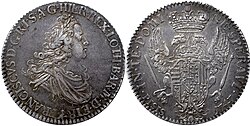Duchy of Lorraine
Duchy of Lorraine Duché de Lorraine ( Luxembourgish ) | |||||||||
|---|---|---|---|---|---|---|---|---|---|
| 959–1766 | |||||||||
| Motto: Un pour tout ou Une pour toutes ( Roman Catholicism | |||||||||
| Demonym(s) | Lorrainian | ||||||||
| Government | Duchy | ||||||||
| Duke | |||||||||
• 959–978 | Frederick I of Bar | ||||||||
• 1737–1766 | Stanisław Leszczyński | ||||||||
| History | |||||||||
• France | 1766 | ||||||||
| |||||||||
| Today part of | |||||||||
| Part of a series on |
| Lorraine |
|---|
 |
The Duchy of Lorraine (French: Lorraine [lɔʁɛn] ⓘ; German: Lothringen [ˈloːtʁɪŋən] ⓘ), originally Upper Lorraine, was a duchy now included in the larger present-day region of Lorraine in northeastern France. Its capital was Nancy.
It was founded in 959 following the division of
In 1737, the duchy was given to
History

Lotharingia
Lorraine's predecessor, Lotharingia, was an independent Carolingian kingdom under the rule of King Lothair II (855–869). Its territory had originally been a part of Middle Francia, created in 843 by the Treaty of Verdun, when the Carolingian empire was divided between the three sons of Louis the Pious. Middle Francia was allotted to Emperor Lothair I, therefore called Lotharii Regnum. On his death in 855, it was further divided into three parts, of which his son Lothair II took the northern one. His realm then comprised a larger territory stretching from the County of Burgundy in the south to the North Sea. In French, this area became known as Lorraine, while in German, it was eventually known as Lothringen. In the Alemannic language once spoken in Lorraine, the -ingen suffix signified a property;[citation needed] thus, in a figurative sense, "Lotharingen" can be translated as "Land belonging to Lothair", or more simplified *Lothair's realm*.
As Lothair II had died without heirs, his territory was divided by the 870 Treaty of Meerssen between East and West Francia and finally came under East Frankish rule as a whole by the 880 Treaty of Ribemont. After the East Frankish Carolingians became extinct with the death of Louis the Child in 911, Lotharingia once again attached itself to West Francia, but was conquered by the German king Henry the Fowler in 925. Stuck in the conflict with his rival Hugh the Great, in 942 King Louis IV of France renounced all claims to Lotharingia.
Duchy of Upper Lorraine
In 953, the German king
Lower Lorraine disintegrated into several smaller territories and only the title of a "
The border between the
Due to the weakening of Imperial authority during the 1618–1648
In 1737, after the
-
Lotharingia divided, around 1000 AD
Alsace, ceded toSuebia(Swabia) in 925
Upper Lorraine after 928
Lower Lorraine after 977 -
Lorraine as it was 1618–1648
-
Map of the Duchy of Lorraine (1756), showing its somewhat dispersed communes by region of France and Germany, for the latter the English and German term for the region is Saarland.
-
Map of the Duchy of Lorraine (1756) within the modern region.
-
Cross of Lorraine, symbol of Lorraine since the 15th century
-
Coat of arms of the Duchy (1697)
-
Full coat of arms of the Duchy, Siebmachers Wappenbuch, 1703[2]
Culture
Two regional languages survive in the region.
Lorrain is a Romance dialect spoken by a minority in the southern part of the region.
The duchy produced a number of important painters, including Claude Lorrain, Georges de La Tour and Jean LeClerc.
Like most of
), Lorrain and Lorraine Franconian were largely replaced by French with the advent of mandatory public schooling in the 19th and 20th centuries.See also
- List of rulers of Lorraine
- Lorraine region
- Lotharingia
References
- Augustin Calmet(1745). "Sur les sceaux,armoiries, couleurs, devises, cris de guerre, titres des Ducs de Lorraine". Histoire de Lorraine. Leseur..
- ^ Siebmacher, Johann (1703). Erneuertes und vermehrtes Wappenbuch... Nürnberg: Adolph Johann Helmers. pp. Part I Table 6.
Further reading
- Herrick, Linda & Wendy Uncapher. Alsace-Lorraine: The Atlantic Bridge to Germany. Janesville, WI: 2003.
- Hughes, S. P. (2005) "Bilingualism in North-East France with specific reference to Rhenish Franconian spoken by Moselle Cross-border (or frontier) workers."[1]
- Putnam, Ruth. Alsace and Lorraine: From Cæsar to Kaiser, 58 B.C.-1871 A.D. New York: 1915.












